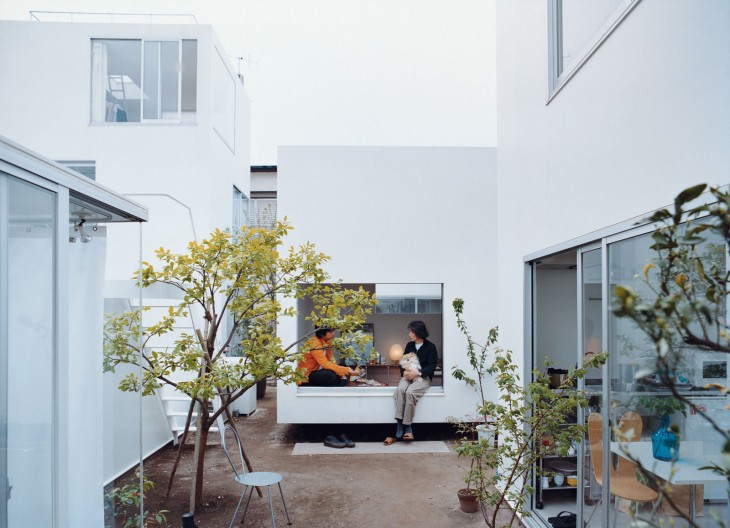The Moriyama House and ‚Cooking, Yo-ing, Thinking’
The Moriyama House by the Office of Ryue Nishizawa is located in the Tokyo metropolitan area. The site includes a whole bloc, although just a single man and his mother own it. The main idea of the architect was to rethink the traditional Japanese courtyard house and create an open cluster system, which can be used in various ways. Therefore the room elements are very flexible. They can be inhabited by the owners but as well easily rented. The conventional closed structure of the house is exploded. The elements are spread over the site. The house mingles with the outside. Nature is entangled with the cultural environment. The spaces amongst the living boxes are on the one hand open spaces, on the other hand closed and merged with the indoor rooms. They are an extension of the living rooms. However, the housing elements are quite isolated at the same time. Windows are never orientated towards each other. They either face a wall or the open sky to maintain privacy.
In ‘Cooking, Yo-ing, Thinking’ Stanford Kwinter is concerned about the perception of nature and how digitalization changes things. In his theory, human mankind is a part of nature and not something separated, acting within it. Furthermore he states that computers should not be seen as simple tools. They are something far more powerful. He compares them to the very first stone tools, which started the whole evolution of human civilization. Computer change the way we live, the way we perceive things, even the way we think. They create a completely new environment – the digital one. There are new social spaces for communication and interaction. Still this new system acts very similar to the natural environment. Kwinter states, that it should be used to connect us again closer to nature. The more relations are created between natural, cultural and digital environment, the better. Old traditions should be always rethought to create something new. If technical standards are developed enough but also the thinking of the society has changed and is ready for something new, things can change.
The Moriyama House realizes Kwinter’s ideas in ‘Cooking, Yo-ing, Thinking’. The traditional Japanese courtyard is altered to develop new spaces. It is an intangible relation. Garden and indoor rooms mix and create an interesting array of semi-open spaces. Nature blurs with social space. It is part of the house. The garden is entangled with the housing elements. Social space can emerge within the blocs. The boxes correlate with each other, the ‘outside’ space is woven with the inside. . Landscape, city, and house become indistinguishable. It is a building and a system at the same time. The site is both private and public at the same time. It is not closed anymore. Everyone from the street can walk in between the blocs. But it is a disturbed relation as well: the elements are isolated, the windows never interact with each other. While the site is open to the street, the housing blocs are secluded. One has to leave one box to get to another ‘room’. The system connects and divides at once.
Personally I find it very interesting, how the environments interact. I think those interconnections are the most remarkable focuses in nowadays architecture. The boarders within the environments fade, it gets harder to tell where one stops and the other starts. Architecture becomes a living organism, not an object.

